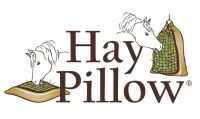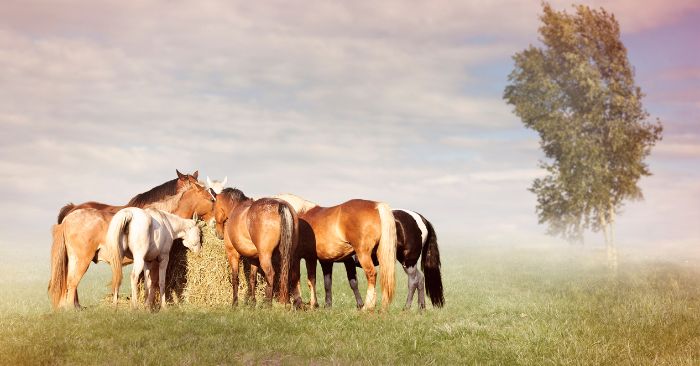Preventing Equine Gastric Ulcers - How Forage Buffers Acid
Read on to learn how and why gastric acid causes ulcers - and what you can do to help prevent ulcers from occurring.

Understanding the Equine Stomach
The lower portion produces gastric acid - and mucus - which helps to buffer the acid. The upper portion has squamous epithelium – similar to our skin - which offers no protection, making it even more susceptible to damage by gastric acid.
Horses Produce Gastric Acid 24/7 - Saliva is Key to Buffering
In nature, horses will voluntarily take breaks to sleep and rest for periods of time, typically no longer than an hour. In domestication, involuntary periods of time without forage can be physically painful and mentally stressful. Mental and physical experiences are synonymous in that each has an influence on the other.
According to Martine Hausberger, PhD, director of the Laboratory of Animal and Human Ethology, a branch of the French national research center (CNRS) and the University of Rennes:
“It is well-known that horses are trickle feeders that would naturally consume a semi-continuous supply of forage for 40-70% of each 24-hour period....It is also known that horses can experience gastrointestinal discomfort if deprived of food for a mere one to two hours.”
Gastric Acid Build Up - The Math
- The average 1,000 pound horse produces 16 gallons of gastric/hydrochloric acid daily.
- The stomach only has a 2 to 4 gallon capacity.
- The stomach can empty in 20 minutes - 2 hours depending on the type of feed and rate of consumption. The faster feedstuff is consumed, the less time it spends in the stomach hindering the initial stages of the digestion process - thereby passing quickly and only partially digested to the hindgut. The result of large meals consumed in short periods of time.
- The math results: 16 gallons divided by 24 hours = .66 gallons produced per hour
- See more: Equine Gastric Acid - 12 Facts You May Not Know
If we assume the stomach empties in 1 hour - with a 3 gallon capacity - the gastric acid can reach the upper half of the stomach (1 1/2 gallons) in a little over 2 hours.
In addition, the pH of the acid is not being reduced by saliva (rich in bicarbonate) because 1) the horse is without forage, and 2) without chewing, there is no saliva production. Due to this fact alone, equines were not designed to be deprived of forage long enough for the gastric acid to reach the unprotected upper portion of the stomach, if stationary.
Movement (without Adequate Fiber) Doubles the Equation
What Ulcers Look Like
How to Prevent Gastric Ulcers
- Offer free choice forage (hay or pasture). If overweight, offer slow fed free choice forage with appropriate tested hay - ideally less than 10% Non Structural Carbohydrates (NSC).
- Limit feeds that are high in sugar and starch (NSCs), which can cause hindgut acidosis.
- Avoid nonsteroidal anti-inflammatory drugs (NSAIDs) such as phenylbutazone (bute) and banamine.
- Never exercise your horse on an empty stomach...ever!
- Don't transport your horse on an empty stomach.
Minimize stressful situations, which can include:
- Lack of forage
- Confinement
- Lack of movement
- Lack of direct physical interaction with other herd members/isolation
- Pain
- Lack of nutrients, vitamins and minerals necessary for proper thyroid, hormone and neurological function
- Rigorous training
- Travel
Closing Thoughts
Helpful How to Resources for Happier Healthier Horses
- Sand Colic - The Surprising (Simple) Cure & Prevention
- Causes of Equine Ulcers – 7 Stress Factors & Solutions
- How to Introduce & Incorporate Free-Choice Forage: An Action Plan
- Slow Feed Solutions for Any Environment
- How I Chose the Best Slow Feeder for My Horse
- Feeding Miniature Horses & Donkeys: Why Slow Fed Forage is Best
- A Safer Always Have Hay Source – Mature Grass Hay
- 6 Great Reasons to Feed Your Horse from Ground Level
- 9 Benefits of Slow Feeding Horses
- 7 Slow Feed Dos and Dont's for Horses
- 7 Easy Ways to Help Prevent Colic
- Never Exercise Horses on an Empty Stomach...Ever
- Why You Shouldn't Transport Horses On An Empty Stomach
- Keeping Horses Warm Naturally – Internally and Externally
- Why Most Horse Prefer to Eat Outside
- Horse Boredom Busters - Toys & Enrichment Tips for Stall or Pasture
- Karyn Malinowski, Ph.D. (2016) Reviewed in 2004 by Carey Williams, Ph.D. Stress Management for Equine Athletes. Retrieved from https://esc.rutgers.edu/fact_sheet/stress-management-for-equine-athletes/
- What You Need to Know About Equine Stomach Acid retrieved from: https://thehorse.com/110702/what-you-need-to-know-about-equine-stomach-acid/
- All Wound Up: Is Your Horse ‘Stressed Out’? retrieved from: https://thehorse.com/113401/all-wound-up-is-your-horse-stressed-out/




